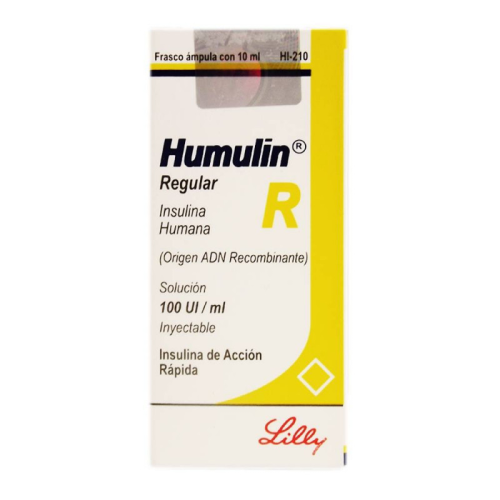Humulin R 100IU (Vial)
- Brand: Lilly
- Product Code: Humulin R 100IU (Vial)
- Availability: In Stock
-
$71.00
CLASSIFICATION
Hormone and Synthetic Substitute / Antidiabetic Agent
ACNE
No
WATER RETENTION
No
HBR
No
HEPATOTOXICITY
No
AROMATIZATION
No
MANUFACTURER
Lilly
WAREHOUSE
International Warehouse 2
SUBSTANCE
Insulin
,
Insulin is a potent anabolic hormone produced by all humans, playing a crucial role in maintaining a healthy physiology. While it's naturally synthesized in the body, those with diabetes often require exogenous insulin. Some athletes also use it to support lean muscle growth. However, the off-label use of insulin can be extremely dangerous, so caution is essential.
Exogenous insulin was first introduced in the 1920s, sourced not synthetically but from the pancreases of dogs, then later from cattle and pigs. Although the extraction process raised concerns over purity, the benefits of exogenous insulin were clear, as it saved many lives; without insulin treatment, diabetes can be fatal. By the 1970s, these purity concerns had largely been addressed, leading to the introduction of synthetic insulin by Ciba in 1975. The synthetic version was further refined in 1982 with the launch of Humulin-R, which is an exact replica of human insulin and received FDA approval.
Functions and Characteristics of Insulin:Insulin, classified as a peptide hormone, is produced by the pancreas and is vital for the use and regulation of glucose, amino acids, and fatty acids. It prevents the metabolic breakdown of glycogen, fat, and protein.
Diabetes patients may require insulin for two primary types: Type I diabetes, where the body does not produce sufficient insulin, and Type II diabetes, where insulin is produced but not effectively utilized by the body, often due to obesity.
Insulin positively influences the liver by promoting the conversion of glycogen to glucose and inhibiting non-carbohydrate to glucose conversion. Additionally, it facilitates the uptake of glucose into cells, contributing to muscle growth. Elevated insulin levels have been associated with increased protein synthesis, improved bone density, and boosted production of Insulin-Like Growth Factor-1 (IGF-1), which shares structural similarities with insulin and is also anabolic.
Moreover, insulin has been shown to increase levels of Luteinizing Hormone (LH) and Follicle Stimulating Hormone (FSH), which could potentially elevate testosterone production in the body—though this effect is not particularly strong.
Insulin Effects:Insulin's primary effect across all types of diabetes is regulating blood sugar levels. Due to its anabolic and anti-catabolic properties, insulin can also benefit athletes. Unfortunately, those without diabetes who use insulin off-label risk significant fat gain and even life-threatening situations if not managed correctly.
Despite these risks, many athletes are drawn to the anabolic and anti-catabolic benefits of insulin. However, it’s crucial to manage body fat levels closely, as high insulin levels can hinder the body's ability to burn stored fat. Athletes must follow a strict, well-planned diet to ensure that glucose and protein are directed towards muscle rather than fat storage. The optimal time for insulin administration is right after a rigorous weight training session, ideally alongside food, which we will discuss in the administration section.
With effective control, it’s possible to gain considerable lean muscle mass using insulin, although managing body fat can be challenging. Utilizing anabolic steroids with insulin along with Human Growth Hormone (HGH) is often recommended for athletes to enhance growth and aid in fat control.
Potential Side Effects of Insulin:The primary concerns with insulin revolve around hypoglycemia, particularly in performance contexts. For diabetic patients, well-managed doses typically prevent major issues, but for athletes, hypoglycemia can be a significant risk. Although hypoglycemia may seem mild, it can have severe consequences, including death.
Hypoglycemia occurs when blood sugar levels drop too low, making it the principal side effect of insulin. Symptoms of hypoglycemia include:
If hypoglycemia symptoms develop, it's crucial to consume simple carbohydrates immediately. Options include candy, sugary drinks, or juice. Regardless of the symptoms, individuals should avoid sleeping after administering insulin, as drowsiness may signal a need for more carbohydrates. If severe hypoglycemia occurs, medical help should be sought without delay. Given these risks, it's advisable not to administer insulin when alone; having someone present is essential for safety.
Another frequent inquiry regarding insulin side effects is the severity of hypoglycemia. Although manageable in many cases, it can lead to a diabetic coma without warning. There have been multiple reported fatalities linked to performance-based insulin use, highlighting the gravity of the situation.
Beyond hypoglycemia, allergic reactions can occur, leading to swelling, itching, irritation, or tenderness at the injection site; these are rare but may also include symptoms such as rash, shortness of breath, rapid heartbeat, wheezing, or hypotension. If any adverse effects arise, it is vital to seek medical attention promptly.
A final potential side effect involves localized fat accumulation, as repeated injections in the same area may promote greater fat storage there. Therefore, varying injection sites is crucial.
Insulin Administration:When treating diabetes, insulin dosing varies greatly based on individual patient needs, with no standardized guideline.
In performance enhancement contexts, several types of insulin are available, including both short- and long-acting formulations. For athletes, fast-acting options like Humulin-R, Humalog, and Novolog are the most beneficial.
Humalog acts swiftly, taking about 15 minutes to show effects, peaking in 30-90 minutes, with an activity duration of 3-5 hours. Novolog and Humulin-R have similar timing but are somewhat slower, with Humulin-R being the least rapid. While Humalog is a preferred choice, obtaining a prescription can be challenging, while Humulin-R is available over the counter and is more accessible for most athletes.
For performance enhancement, the typical starting dose is 1 unit of insulin per 10 pounds of body weight, though first-time users should begin at a lower dose. It's advisable to start at 1 unit immediately following weight training and gradually increase by 1-2 units until an optimal range is established. If symptoms of hypoglycemia appear and persist despite consuming large amounts of carbohydrates, the dosage may need to be reduced; many individuals may not require the full dose.
The best time for insulin administration is right after weight training. Following the injection, a minimum intake of 100g of carbohydrates is recommended, along with approximately 40-50g of protein.
Although 100g of carbohydrates is the baseline, some may require more depending on insulin dosage. Care must be taken not to overuse insulin, starting with small doses and increasing only as necessary.
It’s critical to keep fast-acting carbohydrates readily accessible post-injection in case of hypoglycemic symptoms. A responsible user of insulin always ensures that enough carbohydrates are on hand. If symptoms arise, carbohydrates should be consumed until relief is achieved. Following the post-injection meal, the individual should plan for another meal soon after.
Insulin Summary:Insulin plays a vital role in maintaining health and proper bodily functions. While it can significantly enhance muscle growth when used carefully, the associated risks should not be overlooked. Many individuals may achieve their performance goals without using insulin and find better long-term results by avoiding it. Nonetheless, it remains popular in competitive bodybuilding communities, where genetic advantages and the use of other hormones are common. Regular gym-goers using performance-enhancing substances are likely to experience increased fat gain when using exogenous insulin.
Furthermore, some athletes, particularly those less concerned with physique, may find insulin appealing since it is not detectable in drug tests. These athletes might use it in combination with HGH and low doses of testosterone or thyroid hormones while keeping their overall insulin levels low to avoid detection.

